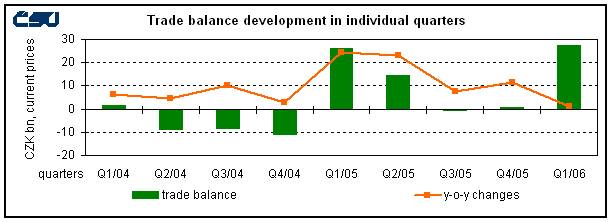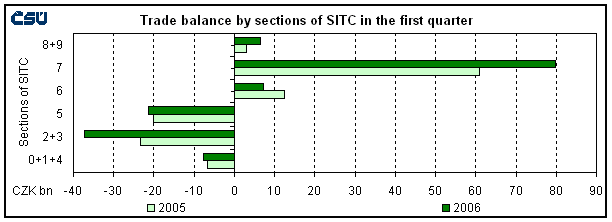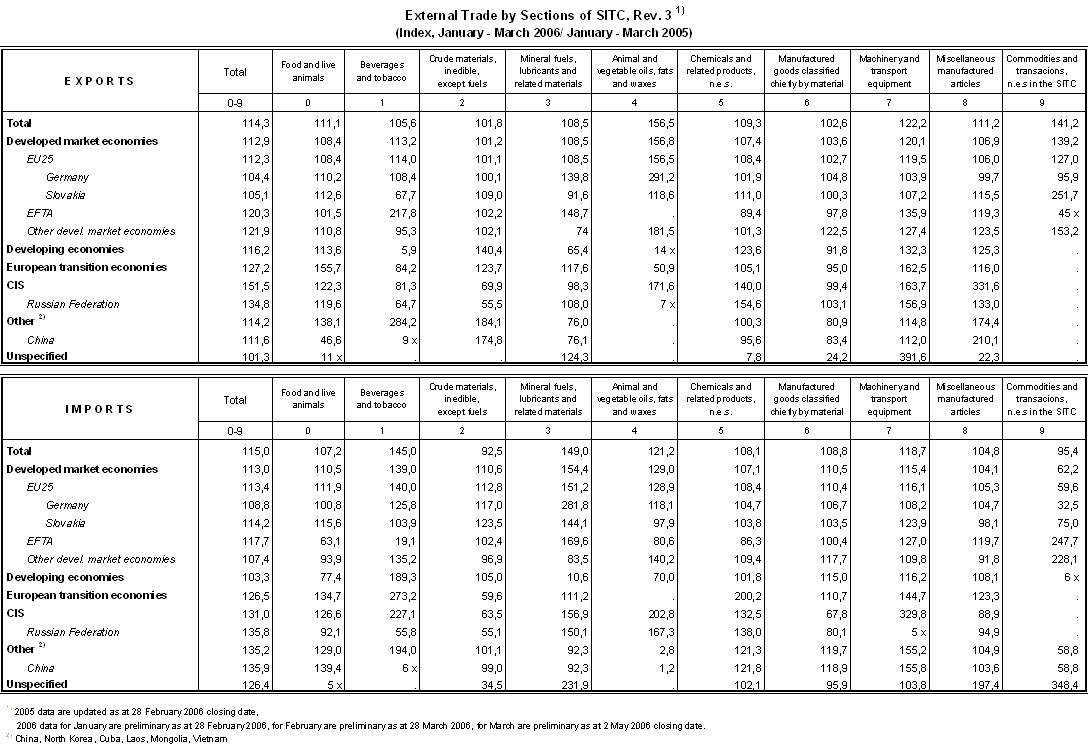External trade - 1. quarter of 2006
Product Code: e-6032-06
External trade in the first quarter of 2006
In external trade 1 in Q1 2006 the long-term trend of the previous two years, when in all quarters exports grew faster than imports year-on-year, was interrupted. Q1 2006 compared to Q1 2005 was characterised by:
- growth of exports fell behind the growth of imports by 0.7 percentage point. 2 Dynamics of exports and imports were high and reached two-digit values – exports 14.3% and imports 15.0%. There has been a change compared to Q1 2005 – the growth rate of exports decreased and the growth rate of imports increased. External trade turnover was higher by 14.6% i.e. by CZK 124.1 billion and amounted to CZK 973.4 billion; the contribution of exports to the turnover, which rose by CZK 62.6 billion made 50.4%, the contribution of imports, which was higher by CZK 61.5 billion, represented 49.6%. Under the influence of appreciation of CZK against EUR, exports and imports in EUR grew faster (20.0% and 20.6%, respectively), while depreciation of CZK against USD led to a slower growth of exports and imports in USD (10.0% and 10.6%, respectively);
- surplus of external trade was higher by CZK 1.1 billion. Trade balance, which was in all months of Q1 2006 active, reached a surplus of CZK 27.3 billion (coverage of imports by exports decreased from 106.4% to 105.8%). External trade balance territorially improved except CIS 3 and other states 4 in all main territorial areas and in terms of the commodity structure only in machinery and transport equipment and in miscellaneous manufactured articles. Mainly the growth of exports of machinery and transport equipment makes an increasing surplus of trade in this commodity group;
- in external trade by group of countries, states of the EU25 had a weakening share in the total exports and imports. However, the EU25 states, with their share of 84.2% in total exports and 70.6% in total imports, played a key role in the external trade of the Czech Republic. A positive aspect was a higher share of CIS countries and European transition economies in total exports. In imports, the share of developing economies weakened, the position of CIS countries and other states strengthened significantly;
- in the commodity structure were apparent increases (though differentiated) in exports and imports in all sections of SITC. A highly above-the-average increase was seen in exports of machinery and transport equipment leading to the strengthening of their position in total exports from 50.1% to 53.6%, this being at the expense of all other sections of SITC. Above-the-average increases in imports were recorded for crude materials, inedible, and mineral fuels, and machinery and transport equipment. These sections of SITC raised their share in the total imports. Crude materials, inedible, and mineral fuels concentrated the biggest external trade deficit (CZK 37.2 billion) with a marked year-on-year deterioration (by CZK 13.9 billion). Deficit of trade in chemicals and related products remained the second highest (CZK 21.4 billion).

Development of external trade in Q1 2006 was influenced by both positive and negative effects.
Among the positive effects were in particular:
- the continuing growth of industrial production. In January to February 2006 the industrial production index reached 113.8, of which in manufacturing 114.9. The biggest year-on-year increase was recorded in manufacture of transport equipment (+35.9%). The growing output of manufacturing (mainly of the new plants built with the help of foreign investments) considerably participated in the year-on-year growth of exports.
The most important item of exports of manufacturing was road vehicles whose exports increased by 31.6% year-on-year. Their share in the total exports was 19.1% in Q1 2006 (16.6% in Q1 2005), of which motorcars made up 10.5% (8.1%) and parts and accessories of the motor vehicles 7.6% (7.3%). Motorcars made up more than 27% and parts and accessories of the motor vehicles almost 10% of the total increase in exports. The surplus of external trade in motorcars grew from CZK 25.3 billion in Q1 2005 to CZK 42.3 billion in Q1 2006 and in parts and accessories of the motor vehicles from CZK 15.4 billion to CZK 15.8 billion. Among other important products of mechanical engineering, a high relative increase was recorded for exports of computer technology (+56.2%), which raised the surplus of these products by CZK 6.3 billion;
- improvement of the economic situation worldwide and mainly in the countries of the Euro-zone, where certain signs of economic recovery were shown. However, there are still considerable differences among individual countries. From the point of view of the Czech Republic’s external trade is important the recovery of German economy.
Among the negative effects on the external trade development were in particular:
- unfavourable terms of trade 5 . Export prices dropped by 2.1% in January to February 2006 compared to the corresponding period of the previous year and import prices increased by 2.8% during the same period. The fluctuation of external trade prices was mainly influenced by the development of prices on the world market and by the strengthening of CZK against EUR and weakening against USD. In January-March 2006, compared to the corresponding period of 2005, CZK appreciated by 4.9% against EUR on average and depreciated by 3.7% against USD. The world prices of industrial crude materials and food grew by 34.5% 6 , this growth was heavily influenced by the prices of petroleum and natural gas on the world market, which rose by 37.3% year-on-year in total. Just the higher prices of petroleum and natural gas had a negative impact on the trade balance and considerably decreased the surplus of the overall trade balance. In Q1 2006 external trade deficit of petroleum, petroleum products and related materials reached CZK 24.8 billion (CZK 15.9 billion in Q1 2005) and of gas, natural and manufactured CZK 17.2 billion (CZK 11.4 billion in Q1 2005). A predominating influence (CZK 8.2billion) on the increase in the trade deficit of petroleum, petroleum products and related materials by CZK 8.9 billion was the growth of prices. The rise in the deficit of gas, natural and manufactured by CZK 5.8 billion was affected by the growth of prices by CZK 4.9 billion;
- a further increase (even though for various reasons) in high trade deficit with China (from CZK 16.8 billion to CZK 23.2 billion) and with Russia (from CZK 15.2 billion to CZK 20.8 billion).
A closer look at the external trade development in Q1 2006 shows that:
- exports grew to all the main groups of countries. Above-the-average dynamics were apparent (apart from exports into the EU25 states and other states) for exports to CIS countries, European transition economies, developing economies and other developed market economies. The prevailing part of the absolute increase of total exports was (even though with the mentioned below-the-average growth) realized by increasing exports into the EU25 states (by CZK 46.2 billion). Favourable development also accompanied exports into other developed market economies (mainly Japan and the United States). The total growth rate of exports to the EU25 reflected various dynamics of exports to individual states. Exports to the majority of states recorded above-the-average growth (e.g. Belgium, France, Italy, Hungary, the Netherlands, Poland, the United Kingdom and Spain), less dynamic were exports to Slovakia, Germany (the absolute growth belonged, however, to the highest), and Sweden, and decreases were recorded mainly for exports to Austria. As to other states, worth mentioning are higher exports to the Ukraine, Russia, Romania and India;
- imports were higher for all the main groups of countries. An above-the-average growth was reported for imports from other states, CIS countries, European transition economies, whereas imports from EU25 states, other developed market economies and particularly from developing economies were more moderate. Dynamics of imports from the EU25 were below the average and varied considerably from one EU25 state to another, the absolute growth however represented more than 64% of the total growth of imports. Highly above-the-average increases were recorded particularly for imports from Poland, the Netherlands, France and the United Kingdom, below-the-average growth was apparent for imports from Germany, Italy, Slovakia and Austria. As to imports from other states, higher imports from Russia, China, Japan and Taiwan and lower imports from the United States should be mentioned;
- the external trade balance was a result of increased surplus of trade balance with the EU25 (by CZK 6.6 billion) and with European transition economies (by CZK 1.8 billion) and of lower deficit with developing economies (by CZK 1.6 billion) and other developed market economies (by CZK 1.5 billion) and of increased deficit of trade balance with CIS countries (by CZK 3.9 billion) and mainly with other states (by CZK 6.4 billion).
The biggest surplus was concentrated on the EU25 states (CZK 87.3 billion) and was by CZK 6.6 billion higher year-on-year. Increases occurred particularly in surplus with the United Kingdom (by CZK 3.8 billion), France (by CZK 2.9 billion), Spain (by CZK 2.9 billion) and Belgium (by CZK 2.7 billion); a turn of the deficit into a surplus improved the trade balance with Italy by CZK 3.3 billion and on the other hand a turn of the surplus into a deficit worsened the balance with Poland by CZK 4.6 billion; surplus decreased in trade with Slovakia, Austria and Germany, with whom however the surplus reached CZK 23.5 billion. As to further states, a high deficit, which rose year-on-year (as mentioned above), was registered in trade with Russia and China, deficit in trade with Japan and Taiwan also increased, and balance with the United States and the Ukraine improved.
Changes in the commodity structure of external trade in Q1 2006, compared to the corresponding period of 2005, were noticeable in:
- machinery and transport equipment by highly above-the-average growth of exports (by 22.2%) and hence increasing of their share in total exports. Higher exports by CZK 48.7 billion represented a 77.8% increase of total exports. Imports of machinery and transport equipment recorded a second highest relative growth (18.7%) and the highest absolute increase (by CZK 29.7 billion) among all the SITC sections and a strengthening of the position in total imports. External trade surplus of machinery and transport equipment reached CZK 79.9 billion and grew by CZK 21.3 billion year-on-year. This surplus was mainly contributed to by exports of motor vehicles and computer technology. Surplus was up in trade in motor vehicles by CZK 17.4 billion and office machines and automatic data-processing machines by CZK 6.3 billion;
- manufactured goods classified chiefly by material by below-the-average dynamics of exports (+2.6%) and imports (+8.8%) and hence weakening of their position in total exports (from 23.2% to 20.8%) and in total imports (from 21.7 % to 20.5 %). Surplus of external trade in these goods decreased year-on-year (from CZK 12.4 billion to CZK 7.2 billion). This drop was mainly affected by the increase in the deficit of trade in iron, steel and non-ferrous metals;
- miscellaneous manufactured articles, commodities and transactions not classified elsewhere in the SITC by an increase of surplus (from CZK 3.1 billion to CZK 6.5 billion) due to a higher growth rate of exports (11.2%) than growth rate of imports (4.8%);
- chemicals and related products by below-the-average dynamics of exports (9.3%) and imports (8.1%). Deficit of external trade in these products rose by CZK 1.3 billion. The biggest deficit kept concentrating into medical and pharmaceutical products (CZK 8.6 billion), however, it was by CZK 0.3 billion lower year-on-year;
- crude materials, inedible, and mineral fuels by the highest growth rate of imports (32.3%) among all sections of SITC and below-the-average increase in exports (5.4%). This development, which was strongly influenced by high prices of mineral fuels, affected the year-on-year increase of deficit in this SITC section;
- agricultural and food crude materials and products by the below-the-average growth rate of exports and imports. The higher growth rate of imports (12.1%) against the growth rate of exports (11.6%) showed itself in a year-on-year increase of deficit (from CZK 6.7 billion to CZK 7.6 billion).

| Sections of SITC, Rev. 3 | Sections of SITC, Rev. 3 | ||
| 0+1+4 | agricultural and food crude materials and products | 6 | manufactured goods classified chiefly by material |
| 2+3 | crude materials, inedible, and mineral fuels | 7 | machinery and transport equipment |
| 5 | chemicals and related products | 8+9 | miscellaneous manufactured articles, commodities and transactions not classified elsewhere in the SITC |
1 All the data are at current prices. The January to December 2005 data are updated referring to 28 February 2006 closing date, the January 2006 data are preliminary referring to 28 February 2006 closing date, the February 2006 data are preliminary referring to 28 March 2006 closing date and the March 2006 data are preliminary referring to 2 May 2006 closing date.
2 We should mention a high comparable base of exports in Q1 2005.
3 The Commonwealth of Independent States.
4 China, North Korea, Cuba, Laos, Mongolia, and Vietnam.
5 Import and export price indices in the CR are published later than data on external trade of the CR.
6 See World Price Indices of Industrial Raw Materials and Food in March 2006, CZSO, April 2006.

